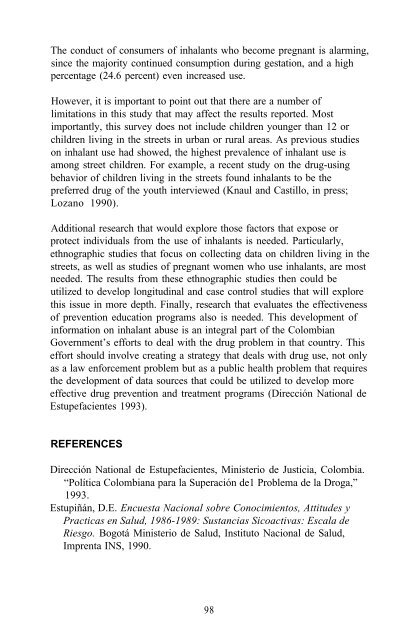Epidemiology of Inhalant Abuse - Archives - National Institute on ...
Epidemiology of Inhalant Abuse - Archives - National Institute on ...
Epidemiology of Inhalant Abuse - Archives - National Institute on ...
You also want an ePaper? Increase the reach of your titles
YUMPU automatically turns print PDFs into web optimized ePapers that Google loves.
The c<strong>on</strong>duct <str<strong>on</strong>g>of</str<strong>on</strong>g> c<strong>on</strong>sumers <str<strong>on</strong>g>of</str<strong>on</strong>g> inhalants who become pregnant is alarming,<br />
since the majority c<strong>on</strong>tinued c<strong>on</strong>sumpti<strong>on</strong> during gestati<strong>on</strong>, and a high<br />
percentage (24.6 percent) even increased use.<br />
However, it is important to point out that there are a number <str<strong>on</strong>g>of</str<strong>on</strong>g><br />
limitati<strong>on</strong>s in this study that may affect the results reported. Most<br />
importantly, this survey does not include children younger than 12 or<br />
children living in the streets in urban or rural areas. As previous studies<br />
<strong>on</strong> inhalant use had showed, the highest prevalence <str<strong>on</strong>g>of</str<strong>on</strong>g> inhalant use is<br />
am<strong>on</strong>g street children. For example, a recent study <strong>on</strong> the drug-using<br />
behavior <str<strong>on</strong>g>of</str<strong>on</strong>g> children living in the streets found inhalants to be the<br />
preferred drug <str<strong>on</strong>g>of</str<strong>on</strong>g> the youth interviewed (Knaul and Castillo, in press;<br />
Lozano 1990).<br />
Additi<strong>on</strong>al research that would explore those factors that expose or<br />
protect individuals from the use <str<strong>on</strong>g>of</str<strong>on</strong>g> inhalants is needed. Particularly,<br />
ethnographic studies that focus <strong>on</strong> collecting data <strong>on</strong> children living in the<br />
streets, as well as studies <str<strong>on</strong>g>of</str<strong>on</strong>g> pregnant women who use inhalants, are most<br />
needed. The results from these ethnographic studies then could be<br />
utilized to develop l<strong>on</strong>gitudinal and case c<strong>on</strong>trol studies that will explore<br />
this issue in more depth. Finally, research that evaluates the effectiveness<br />
<str<strong>on</strong>g>of</str<strong>on</strong>g> preventi<strong>on</strong> educati<strong>on</strong> programs also is needed. This development <str<strong>on</strong>g>of</str<strong>on</strong>g><br />
informati<strong>on</strong> <strong>on</strong> inhalant abuse is an integral part <str<strong>on</strong>g>of</str<strong>on</strong>g> the Colombian<br />
Government’s efforts to deal with the drug problem in that country. This<br />
effort should involve creating a strategy that deals with drug use, not <strong>on</strong>ly<br />
as a law enforcement problem but as a public health problem that requires<br />
the development <str<strong>on</strong>g>of</str<strong>on</strong>g> data sources that could be utilized to develop more<br />
effective drug preventi<strong>on</strong> and treatment programs (Dirección <str<strong>on</strong>g>Nati<strong>on</strong>al</str<strong>on</strong>g> de<br />
Estupefacientes 1993).<br />
REFERENCES<br />
Dirección <str<strong>on</strong>g>Nati<strong>on</strong>al</str<strong>on</strong>g> de Estupefacientes, Ministerio de Justicia, Colombia.<br />
“Política Colombiana para la Superación de1 Problema de la Droga,”<br />
1993.<br />
Estupiñán, D.E. Encuesta Naci<strong>on</strong>al sobre C<strong>on</strong>ocimientos, Attitudes y<br />
Practicas en Salud, 1986-1989: Sustancias Sicoactivas: Escala de<br />
Riesgo. Bogotá Ministerio de Salud, Instituto Naci<strong>on</strong>al de Salud,<br />
Imprenta INS, 1990.<br />
98
















